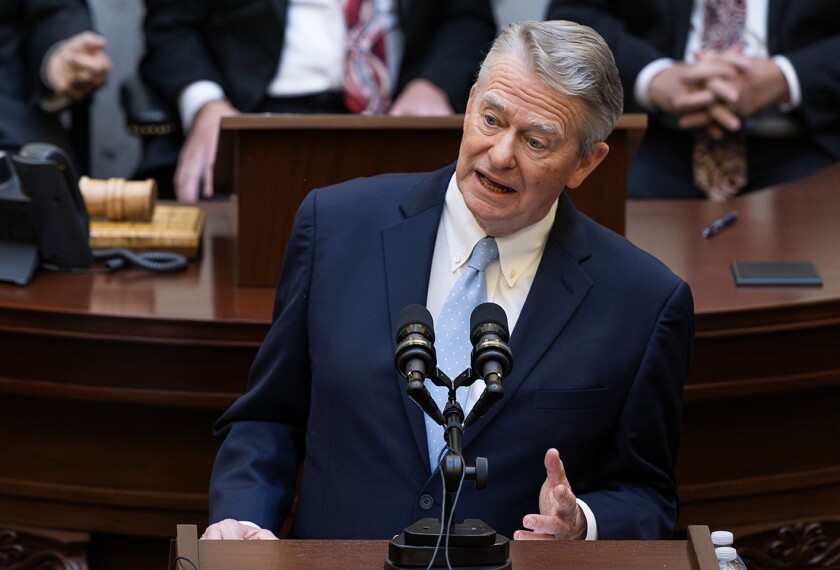In Kansas, where cutting taxes is seemingly a favorite pastime, educators have wrestled with politicians for decades over who gets what out of the state’s ever-shrinking coffers. That culminated in the state’s highest court ruling in 2014 that the state’s spending habits on school aid was unconstitutional, a monumental move and a potential victory for starving school districts.
But now, just as politicians get ready to craft a new formula, a legislative committee says the state government needs to more heavily scrutinize school spending. Superintendents are spending $1 billion more than they did a decade ago in state money, and yet student performance has either stagnated or fallen, according to a controversial report issued by the committee last week.
The state legislature should conduct more frequent audits of districts, consolidate services, and dictate what efforts should be funded to improve student learning, the report says. In addition, it recommends the state board of education hire an outside company to create its academic assessments and have all its high school students take the ACT.
“Taxpayers across the state have to get a better handle on where their money goes,” said Rep. Ron Highland, a Republican and the chairman of the Committee on K-12 Student Success who authored the report. “There’s no mention of cutting, but in our view, the money needs to get to students who need the most help. That’s been our whole thrust in this conversation.”
Pushing Back
The 12-page report garnered swift response from editorial boards, education advocates, and school district officials who argued that the proposals would just pave the way for further cuts in spending and that more oversight would undermine the authority of the state department of education and local districts. Further, the state’s funding of schools still falls far short of what courts have ruled is an adequate amount.
While recognizing the state has room to grow academically, Mark Tallman, a spokesman for the Kansas School Board Association, said legislatures should admire how much district officials are able to accomplish with so little money.
“In our view, the decisions we’re making seem to be making a difference.” Tallman said.
Legal Battle
The three Democrats on the 13-member committee contend that the report was heavily influenced by the Kansas Policy Institute, a conservative anti-tax organization, and have said they will issue a counter report.

The committee’s final report did not come attached with recommended legislation, and observers said it was thin on detail as to how the state would enact many of the proposals.
Districts in the Sunflower State have long complained that the state has failed to provide schools with enough money to give its students an adequate education as required under the state constitution. Kansas spends about $4 billion on education, about $13,000 per student. In 2010, Kansas City and four other districts sued the state alleging that it fails to adequately and equitably fund its schools.
In its 2014 ruling, the state’s supreme court ordered the legislature to fix the unequal funding. In response, legislators switched the schools from a per-pupil funding formula to a block-grant formula for two years until they could come up with a new formula. The block grants don’t provide for any annual increases in funding.
Districts again sued, complaining that the block-grant formula didn’t include increases and was also unconstitutional. A panel of three lower-court judges agreed, ordering the legislature to revert to the earlier funding formula. That order is pending a Supreme Court decision.
Across the country, Delaware, Montana, and Nebraska are set to make significant changes to their funding formulas this year. None, except for Kansas and Washington state, however, is tasked with completely overhauling its formula.
(Washington is under a court ruling to come up with a funding formula and is being fined $100,000 a day until it does so.)
The Kansas committee began meeting in October and heard presentations from dozens of education advocates, budget analysts, and district superintendents. In an early draft of the report, Rep. Highland said the state now spends about $1 billion more than it did a decade ago. The state picks up more than half the cost of education, with local and federal tax dollars funding the rest.
Despite that, its academic ranking on some elements of the National Assessment of Educational Progress fell precipitously in the most recent rankings, from 11th in 4th grade math in 2013 to 25th in 2015.
The draft of the report points out that while enrollment in the mostly rural state has climbed only 7 percent, the state has increased its teaching staff by 17 percent and its administrative staff by 41 percent.
“Most alarming was the ‘achievement gap,’ ” Highland writes. “The gap has remained virtually unchanged for decades with significant increases in spending.” About half the state’s students qualify as low-income.
The theory is that “poverty determines an individual’s ability to learn,” he wrote in the draft. “This thinking is discriminating and has no place in education.”
Do More With Less?
Michael Rebell, a professor at Teachers College, Columbia University, who has followed the legal battles over school funding in Kansas, said legislatures would be wrong to tell schools to do more with less.
“In Kansas, I’d take with a grain of salt what the current governor and legislatures have been saying because they haven’t been providing schools with an adequate amount of money for years,” Rebell said, pointing to a study commissioned by the legislature in 2001 that says as much. “I don’t doubt that educational services can be provided in a more cost-effective manner. But that requires close attention to what best practices are.”
The final report, approved by the committee Jan. 19, was stripped of much of its charged language about poverty and school performance. But it kept some key themes, including that the state rein in spending and use a state metric instead of a federal one to determine if students qualify as poor.
And it suggests that the legislature establish subcommittees to examine teacher pay, funding for at-risk students, special education, and whether the state benefits from receiving federal funds.
Meanwhile, the state’s legislators this year are faced with closing a $190 million deficit caused, in part, by Gov. Sam Brownback making almost $7 billion worth of business- and income-tax cuts in recent years. Legislators wrongly predicted the economy would grow with the cuts.
Democrats in the state have doubted that the state’s Republican-dominated legislature will propose a new funding formula this year, forcing the districts to go another year with the block grants.





